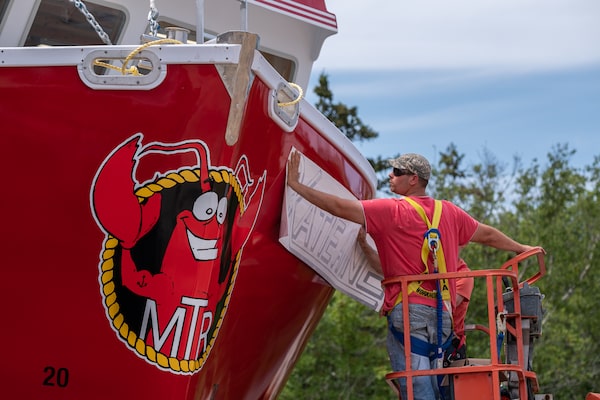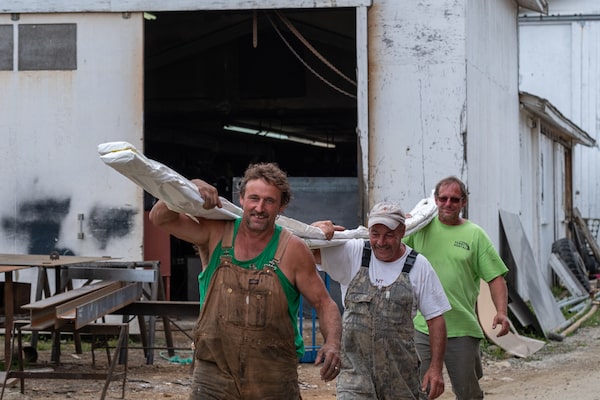
The yard at Wedgeport Boatbuilding, seen from above. The Nova Scotia facility has been doing brisk business lately and is already booking contracts into 2021.Photography by Andrew Tolson/The Globe and Mail
A newly finished lobster fishing boat waits on a trailer in a yard at Wedgeport Boats, like a displaced sea creature ready to return. The Porsche-red hull gleams in the Nova Scotia sun. Standing on the ground in its shadow, the vessel’s owner, Mark Rogers, watches with satisfaction as the vinyl sticker – the kind used for race cars – is applied to the bow, revealing a muscled, smiling cartoon lobster.
It’s the afternoon before the official launch of the Katie Anne – named, according to custom, for Mr. Rogers’s now-grown daughter. The launch has been planned for a Friday, which, as grizzled fishermen will say, is traditionally a day best avoided for a new voyage. But Mr. Rogers figures he’s balanced those odds: A priest is coming to deliver a blessing with holy water and, although he isn’t Roman Catholic, he’s accepted a rosary – once owned by a nun – to hang in the cockpit of the boat, just for luck.
“I would rather have God with me than against me,” he quips. “I can get in enough trouble on my own.”

Peter Lisanti applies a decal to the red hull of the Katie Anne.
But fortune is already smiling on East Coast lobster fishermen and boat builders alike, thanks to a thriving lobster fishery, fuelled by a strong global market, abundant catch and a low dollar.
Fishermen with older boats have been flipping them at prices high enough to make trading up possible, investing in vessels with larger holds so they can stay out at sea longer and swishier accommodation for the crew.
In the past five years, according to the Nova Scotia Boat Builders Association, sales for new builds and repairs in the province have more than doubled – to $110-million in 2018.
When Fraser Challoner and his partner, Skip Muise, first became co-owners of Wedgeport Boats in 2008, they were laying off workers for months at a time almost every year – an especially hard call in a small fishing village such as Wedgeport, located on the southwestern tip of the province, about 300 kilometres from Halifax.
But, as business began to pick up, the company, one of about 60 in Nova Scotia, expanded to a new property and added buildings. Now Mr. Challoner, the general manager, is booking contracts into 2021.
So it’s a good day at Wedgeport Boats, and not only because there’s a cool wind to cut the afternoon heat. Not counting the fleet on land for serving or retrofitting, there are six boats in various stages of construction – a hull with its ribs still showing in one bay; workers fibreglassing a nearly finished hull in another.
“We’re so busy,” Mr. Challoner says, “we can give work away.”

Fraser Challoner, top photo, is co-owner of Wedgeport Boatbuilding with Skip Muise, bottom.
But every boom has its complications, especially when your work is tied to an industry famous for glory-day highs and devastating lows.
For one thing, as the boat-building association’s executive director Jan Fullerton points out, yards are having trouble finding skilled workers to handle all the business on offer right now. That’s meant some poaching between yards, but also a new focus on apprenticeship programs to attract young Nova Scotians into the trade, or bring in skilled workers from other countries.
At Wedgeport, one of the welders who worked on the Katie Anne is Simon An, a 21-year-old from South Korea who graduated recently from Nova Scotia Community College and is hoping to receive his permanent residency in Canada with help from the Wedgeport yard and a provincial immigration program.
Mr. Challoner says that while the yard doesn’t struggle to keep workers, “we have an aging crew,” and not enough certified boat builders coming up behind them.
But yards also have to be careful about the size of their work force, he says, given that the current run of contracts isn’t likely to last. The Wedgeport yard is already planning ahead, expanding its focus to servicing, repairs and Transport Canada inspections, as well as a line of orders for fibreglass fishing boats for a salmon aquaculture company, Mr Challoner says.
When you live off the ocean, you learn fast that what the tides brings in, it also takes out. But for now, and on this day especially, business is bright.

Simon An, a 21-year-old from South Korea, works as a welder at Wedgeport. He's hoping to get his permanent residency through the yard and a provincial immigration program.

Wedgeport's owners say it isn't a struggle to keep workers, but the crew is aging and not enough certified builders are coming who can replace them.

Camille Jacquard, a fifth-generation fisherman, stands on his newly constructed boat, Pelagic Predator.
Once the Katie Anne is launched, the next boat in line belongs to Camille Jacquard, who is also milling around today, Tim Hortons cup in hand, pondering the design of his trim paint. The name is decided: Pelagic Predator. His boat will be designed to “wash, rinse and repeat,” as he puts it, to fish lobster, tuna and swordfish.
But ask Mr. Jacquard, a fifth-generation fisherman, what he’s most excited about, and he says: “the comfort.”
Right now, the cockpit and galley are only framed in, but once it’s done, as with the Katie Anne, it will have a full kitchen, an entertainment system and a small bathroom with a shower.
“You’ve heard of glamping?” jokes Ron Ward, a sales rep with Atlantic Electronics who is here to oversee some final tests on the Katie Anne. “Well, this is glamour fishing.”
Not always so glamorous: As a Globe and Mail investigation found in 2017, commercial fishing is the most dangerous sector in Canada.
But another perk of the boom is that the fleet upgrade will also come with the latest safety equipment and technology. The Katie Anne, for instance, is equipped with sonar that can scan the shape of objects on the ocean floor, to assist with salvaging.
The next day, the launch goes smoothly. With the yard still quiet to avoid distractions, Mr. Muise – who, as production manager, oversees the construction side of the business – carefully backs the Katie Anne down to the water. It’s the trickiest part of the launch, everyone agrees – no matter how many times you’ve done it.
The prayers are delivered and blessings bestowed, and Katie Anne herself smashes the celebratory bottle of champagne on the hull of her namesake.
The Katie Anne will then go through further testing and sea trials in August, before heading to her home port of Saint John.
Meanwhile, the next job calls.
“In my head,” Mr. Muise says, “it’s on to the next boat.”
Which is another reason to celebrate.

Two workers walk through the boat yard in the early-morning mist.
 Erin Anderssen
Erin Anderssen